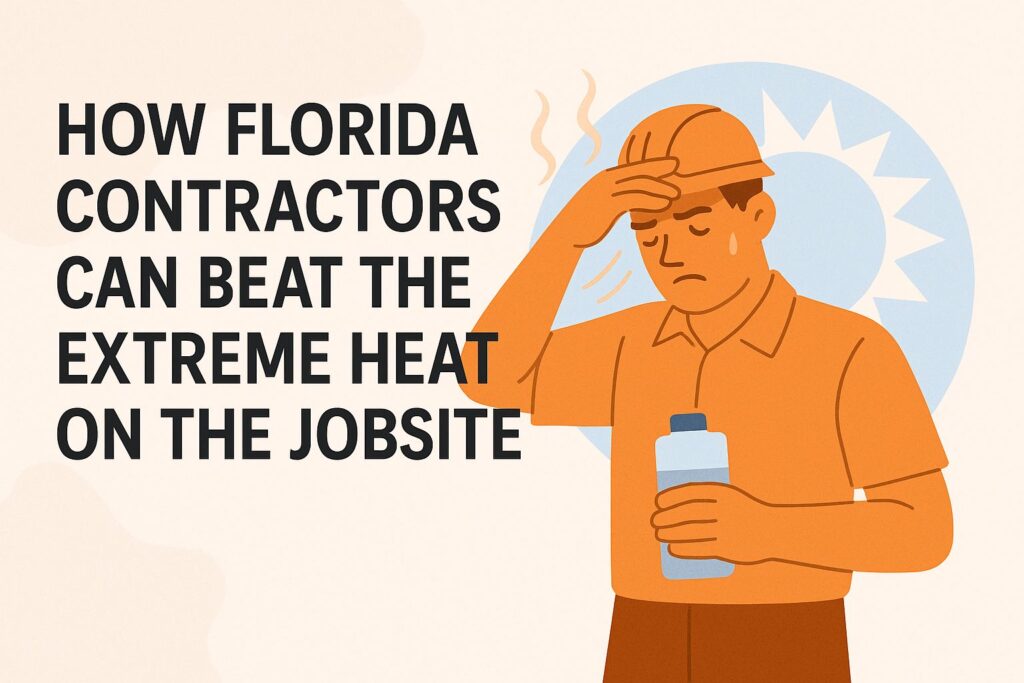
How Florida Contractors Can Beat the Extreme Heat on the Jobsite
When the sun blazes down on Florida job sites under high temperatures, the heat can feel unbearable. As a contractor, handling these extreme temperatures is very challenging; it’s important to keep everyone safe and make sure your team remains healthy and productive. Learn ways to handle heat stress and improve safety at the job site. This includes tips on staying hydrated and changes to the work area to keep your team safe and attentive. Learn how to make hot weather more comfortable and increase the chances of your project’s success.
Overview of Florida’s Climate
Florida’s warm, humid weather often sees temperatures around 92 degrees F in July, creating challenging climate conditions, which can easily lead to heat stress.
These tough conditions can last for 10 to 30 days during the hottest summer months, so outdoor construction workers need to use comfortable work techniques.
To mitigate heat stress, implement measures such as:
- Scheduling work during cooler hours
- Providing ample hydration stations and ensuring adequate water supply
- Utilizing shaded breaks
Wearing lightweight and breathable clothing, such as protective clothing with sun protection, can significantly improve comfort levels. Teaching workers about heat-related illnesses improves safety by making sure everyone knows the symptoms, understands the need for first aid, and takes quick action. Curious about how mobile office rentals can enhance workplace flexibility in such conditions? Our comprehensive guide explains why they are becoming a popular choice.
Importance of Heat Management for Contractors
Proper handling of heat is important for Florida contractors because it affects worker safety, how long workers stay on the job, and project schedules in Florida’s extremely hot weather.
Ignoring how to handle heat stress can cause serious problems. Workers may experience heat-related illnesses, resulting in increased absences, diminished productivity, and potential negative impact on work efficiency. Contractors risk facing legal ramifications under OSHA regulations, which mandate safe working conditions. Failing to comply with these standards can lead to fines and potential lawsuits.
To mitigate risks, it’s essential to implement strategies such as adhering to OSHA guidelines, including:
- Providing hydration stations
- Scheduling breaks during peak heat hours
- Training staff on recognizing heat stress symptoms
These actions ensure worker safety, improve mental health, and keep the project progressing smoothly.
Understanding Heat Stress
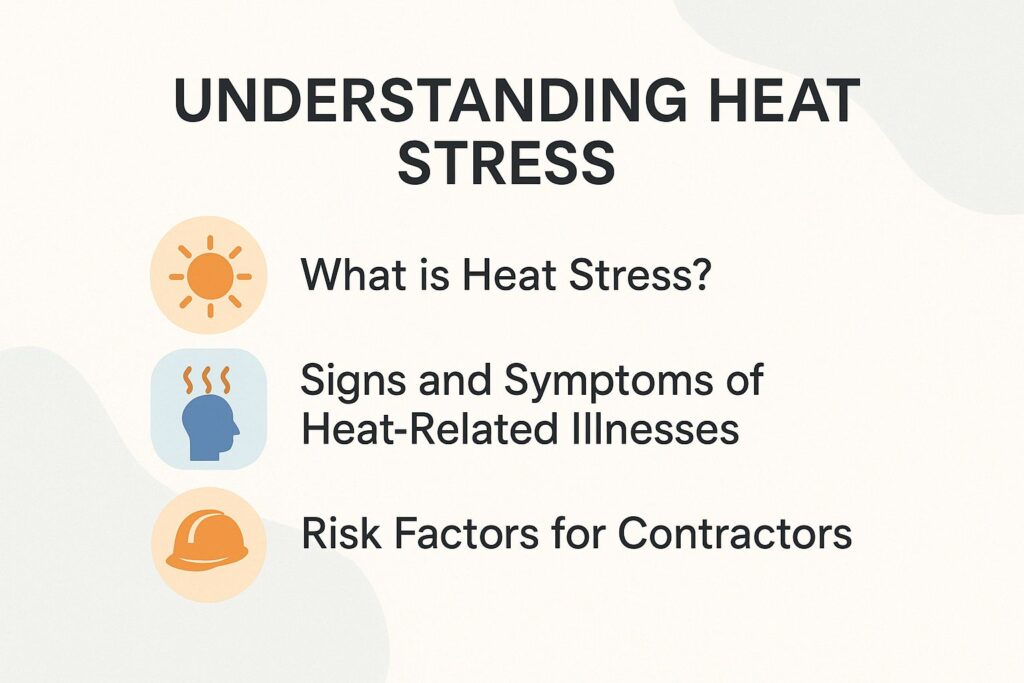
Heat stress happens when the body struggles to keep cool, affecting physical endurance and creating serious dangers for people working outside in Florida’s hot summer.
What is Heat Stress?
Heat stress occurs when heat exposure exceeds the body’s ability to dissipate heat, leading to conditions like heat exhaustion and heat stroke, which are prevalent in the construction industry.
Heat stress can appear in different ways, such as feeling tired from heat, having muscle cramps, and experiencing heat stroke. Each has different levels of seriousness and symptoms. For example, heat exhaustion typifies excessive sweating and fatigue, while heat stroke can result in confusion or loss of consciousness.
These conditions directly impact worker performance, leading to decreased productivity and longer recovery times.
To mitigate heat stress, implement hydration schedules, provide shaded rest areas, and train workers to recognize early symptoms, ensuring a safer work environment and maintaining efficiency.
Signs and Symptoms of Heat-Related Illnesses
Key symptoms of heat-related illnesses include heavy sweating, rapid pulse, dizziness, and confusion, which can escalate without intervention.
Supervisors and workers should also watch for extreme fatigue, headache, nausea, and muscle cramps. If any of these symptoms arise, take immediate action:
- Move the affected person to a cooler area.
- Provide water or electrolyte drinks.
- Remove any excess clothing.
If symptoms don’t get better quickly, contact a doctor. Regular hydration breaks, sun safety tips, and scheduling outdoor work during cooler parts of the day can also help mitigate risks. Teaching employees about these warning signs improves workplace safety and responsiveness.
Risk Factors for Contractors
Contractors are at risk for heat stress due to heavy physical activity, not being used to the heat, and not drinking enough water.
To lower these health risks, contractors should use several forward-thinking approaches.
- Set up hourly breaks for drinking water or fluids with electrolytes to maintain electrolyte balance and keep workers hydrated.
- Acclimatize new workers gradually by increasing their exposure to high temperatures over 5-7 days.
- Adjust work schedules to avoid peak heat hours, incorporating shaded areas and allowing for tasks to be completed during cooler times of day.
Provide training on recognizing heat stress symptoms, ensuring workers are aware of their body’s signals. These steps can greatly improve safety and comfort at the site.
Preventive Measures
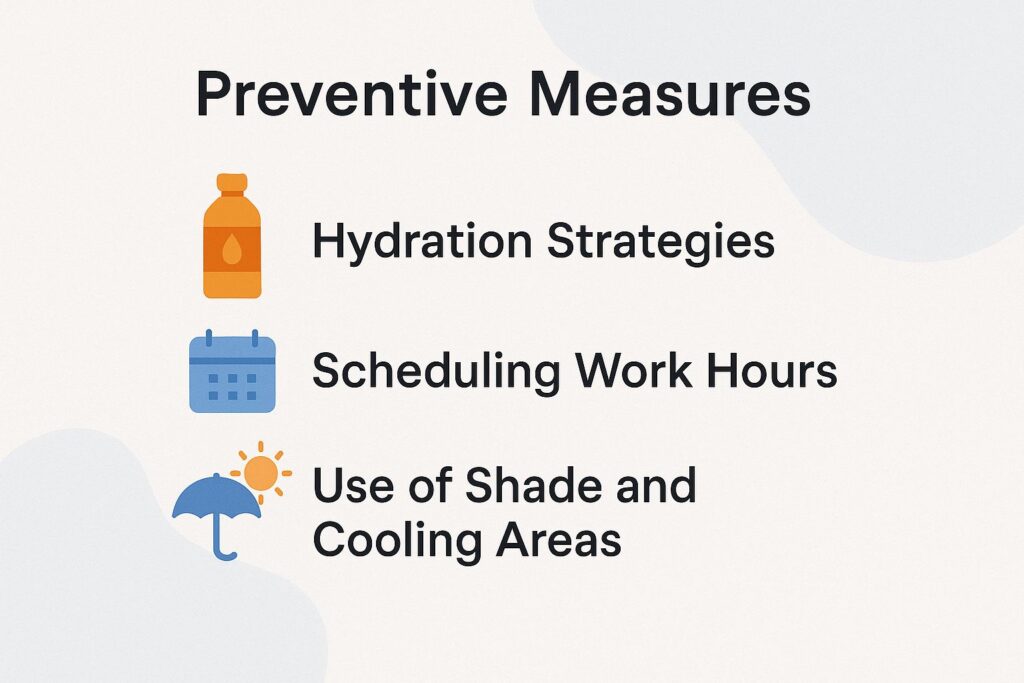
Putting preventive actions in place is important to protect workers from heat-related issues, keeping the work site safer and more efficient during hot weather.
Hydration Strategies
Establishing effective hydration strategies can reduce the risk of heat-related illnesses, with experts recommending at least 2-3 quarts of water daily for outdoor workers.
To achieve this, schedule breaks every 15-20 minutes to drink water regularly.
Provide drinks with electrolytes, like sports drinks or coconut water, particularly during heavy exercise.
Make sure there are drinking stations with coolers full of cold water.
Consider using apps such as WaterMinder or MyWater to help everyone remember to drink water throughout the day.
By combining these strategies, you create an environment that prioritizes hydration and supports overall health in challenging conditions.
Scheduling Work Hours
Adjusting work hours to cooler parts of the day, such as early mornings or late afternoons, can significantly decrease heat exposure for workers.
To implement this, consider starting shifts at 6 AM and finishing by noon during summer months. If you can’t change your work schedule, take longer breaks away from direct sunlight. Aim for at least 30 minutes of rest every two hours.
Incorporating cooling stations equipped with water, fans, and shade can improve overall comfort. Workers should also be encouraged to wear breathable clothing and hydrate frequently.
These strategies help maintain employee health, improve work output, and allow them to stay active throughout the day.
Use of Shade and Cooling Areas
Providing shaded areas or cooling stations on-site can reduce temperatures, aid in recovery time, and help workers recover from heat stress throughout the day.
To effectively create shaded areas, consider using large tarps or pop-up tents. Tarps can reduce temperatures by up to 20 degreesF and are easily adjustable; secure them with weights or stakes.
For a more structured solution, choose tents which offer additional protection from wind and rain, contributing to overall thermal comfort. Cooling areas can significantly improve comfort, especially with added fans or misters, which can lower temperatures by another 10 degreesF.
Putting these strategies into practice improves worker safety and increases productivity in hot weather.
Personal Protective Equipment (PPE)
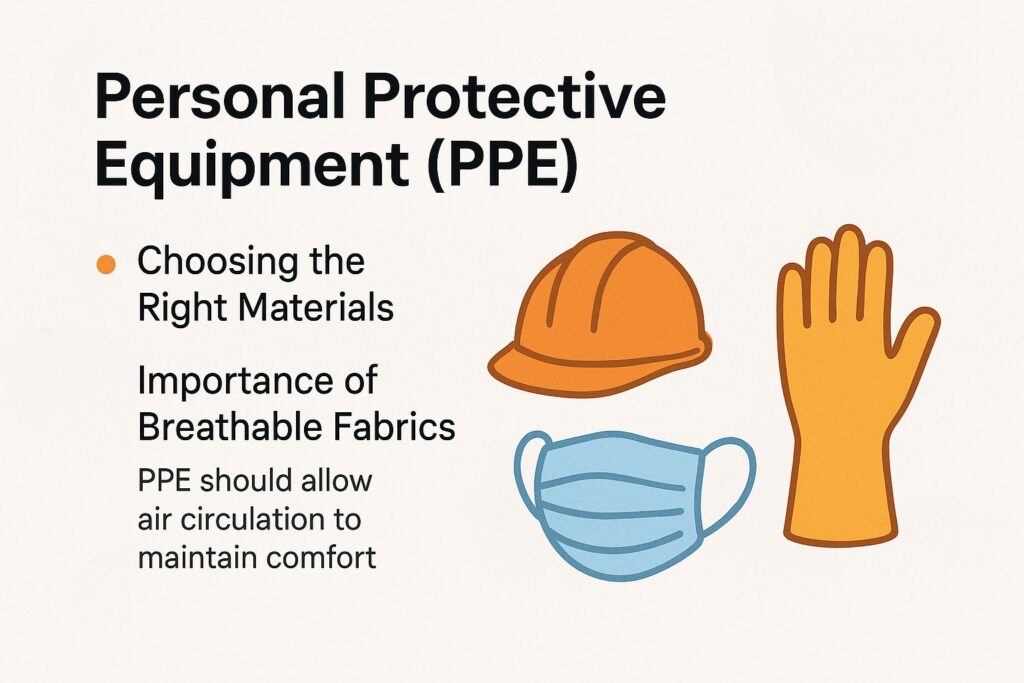
Picking suitable protective gear is essential for contractor safety, particularly in extremely hot weather where usual equipment can be unpleasant.
Choosing the Right Materials
Opting for lightweight, moisture-wicking fabrics for PPE, with a focus on sun safety, can significantly improve comfort, support employee wellness, and reduce heat stress among construction workers.
Along with moisture-wicking fabrics, using:
- cooling vests,
- sun-protective clothing,
- hydration packs,
- helmets with good ventilation
can improve worker safety.
Brands like CoolShirt offer specialized cooling vests that reduce body temperature, while companies like UV Skinz provide effective sun-protective clothing to shield workers from harmful UV rays. Hydration backpacks, such as Camelbak, provide steady access to water while working, and MSA’s helmets allow heat to escape to keep you cool.
By combining these materials, construction sites can promote better safety and comfort for their workforce.
Importance of Breathable Fabrics
Using breathable materials in PPE design allows air to flow, which helps control body temperature and improves worker comfort in hot environments.
For outdoor work, consider PPE options like the Carhartt Force(r) line, made from moisture-wicking and breathable materials that dry quickly while providing UV protection.
The Snickers Workwear 6241 is made from light material, allowing for excellent airflow. Another great option is Helly Hansen Workwear, which uses new ventilation technology to keep workers comfortable.
By choosing garments with these features, companies can significantly reduce heat stress, leading to improved focus and productivity in challenging environments.
Worksite Modifications
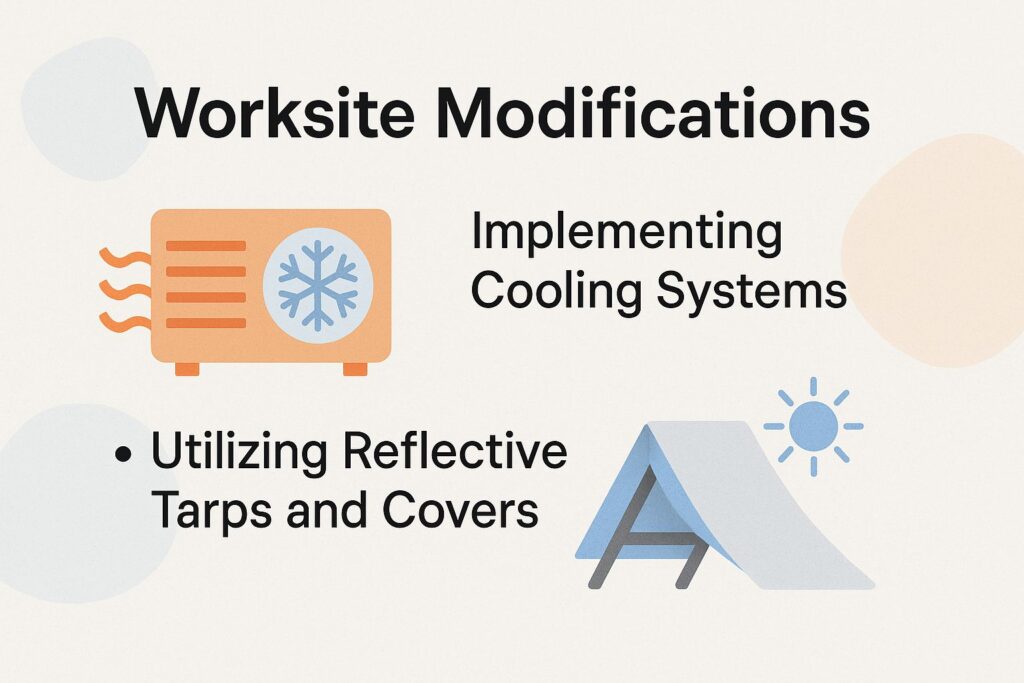
Changing the worksite conditions can greatly reduce heat-related issues, helping contractors stay productive and keep workers healthy.
Implementing Cooling Systems
Investing in effective cooling systems, such as portable air conditioning units and misting fans, can create a safer work environment during extreme heat conditions.
For instance, portable air conditioning units can be positioned in high-temp areas or temporary structures, providing instant cooling relief. Brands like LG and Honeywell offer models that suit various space requirements.
Similarly, misting fans, which spray fine droplets of water into the air, significantly lower temperatures; they work effectively outdoors in conditions where airflow is available.
Implementing these systems has led to a notable reduction in heat-related incidents at construction sites, enhancing worker comfort and productivity.
Utilizing Reflective Tarps and Covers
Incorporating reflective tarps and covers can lower ambient temperatures on-site by up to 20 degreesF, significantly enhancing worker comfort and heat safety.
Products like Coolaroo Reflective Shade Cloth and Mylar Tarps are particularly effective. Coolaroo’s shade cloth blocks up to 90% of UV rays, offering sun protection while allowing air to flow through, which makes it ideal for use outside.
Mylar Tarps, on the other hand, are designed to reflect heat, keeping areas cool underneath. Installation typically involves simple anchoring methods with bungee cords or hooks, ensuring the materials stay in place against wind and maintaining outdoor safety.
By using these materials strategically over high-traffic areas or break zones, construction sites can improve both workforce productivity and jobsite morale.
Training and Awareness for Florida Contractors
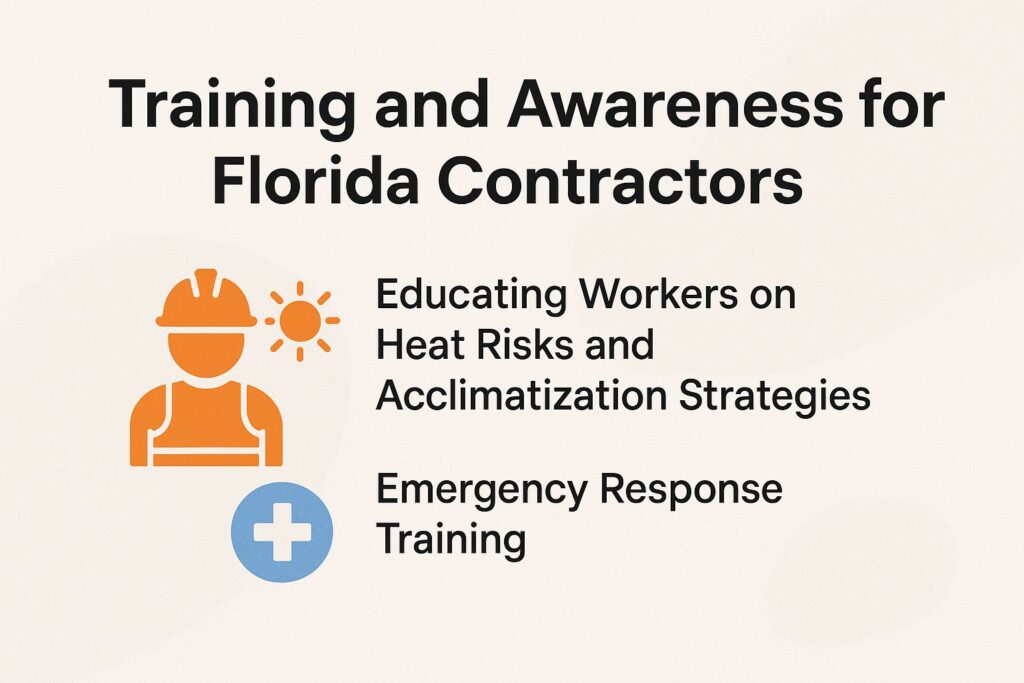
Teaching and training about heat stress is important for Florida contractors because knowledgeable workers can identify and handle heat-related dangers more effectively, ensuring compliance with OSHA guidelines.
Educating Workers on Heat Risks and Acclimatization Strategies
Teaching workers about the dangers of heat stress helps them make decisions that improve their safety at work and adhere to construction safety standards.
To effectively train your team, focus on three main topics: recognizing symptoms of heat stress, hydration strategies, and the proper use of personal protective equipment (PPE).
Use interactive methods such as role-playing scenarios to help workers identify heat stress symptoms early, and provide them with a hydration schedule to encourage frequent water intake, aligning with seasonal preparedness.
Use visual tools, like infographics, to show how to properly use PPE and why it is important for preventing heat-related illnesses. Tools like Quizlet can reinforce learning through quizzes and flashcards, enhancing retention.
Emergency Response Training
Training workers for emergency response helps them know what to do quickly and effectively during a heat-related emergency. Training should cover key areas including first aid for heat exhaustion, proper use of cooling systems and cooling gear, and clear protocols for contacting emergency services.
In first aid, people should learn to recognize signs like dizziness or nausea and help by taking the person to a cooler spot and giving them water.
Knowing how cooling systems work, like fans or portable air conditioners, is important for quick action.
Training should explain basic methods to reach emergency services, so everyone can quickly get help.
Monitoring and Assessment
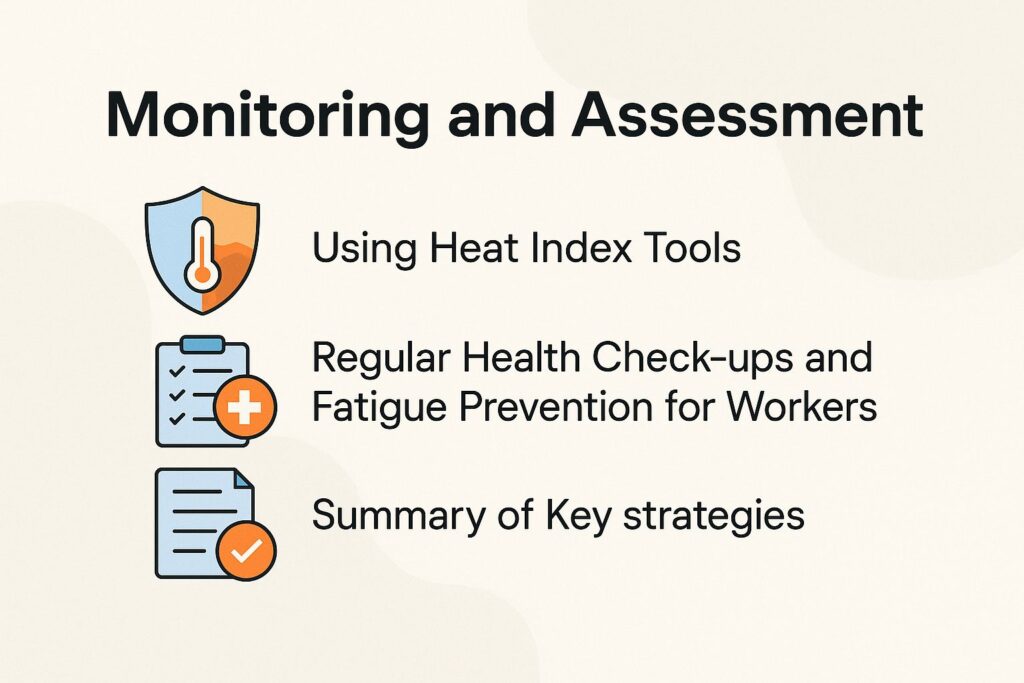
Regularly checking and evaluating temperature conditions at the site is necessary to stop heat-related sickness and keep workers safe, promoting effective risk management and jobsite management.
Using Heat Index Tools
Employing heat index tools can help contractors make informed decisions regarding work schedules and safety measures based on real-time temperature and humidity data, supporting temperature monitoring and environmental safety.
For example, the National Weather Service’s heat index calculator gives important information. When the heat index exceeds 100 degreesF, consider rescheduling outdoor tasks to the early morning or late afternoon to minimize heat exposure.
If the temperature reaches 105 degreesF or higher, make sure workers take a water break every hour and suggest wearing light clothing.
These changes improve safety and keep productivity levels steady, allowing projects to continue without risking health.
Regular Health Check-ups and Fatigue Prevention for Workers
Regular health check-ups can spot early signs of heat stress and confirm that workers are healthy enough to do their jobs safely in very hot conditions, aiding health monitoring and injury prevention.
Schedule appointments every three months to monitor your health. Pay attention to important measurements like hydration levels and body temperature.
Use portable hydration assessment tools, like hydration monitors, to gauge fluid levels quickly. Use digital thermometers to get immediate temperature readings, especially during events with high heat.
Encourage staff to fill out wellness questionnaires to flag any symptoms of heat stress early. Training workers to recognize the signs of heat-related illnesses can create a proactive safety culture, protecting overall workforce health.
Summary of Key Strategies
Key strategies for managing heat stress include effective hydration, proper scheduling, use of PPE, and ongoing worker education and training.
To apply these strategies effectively, tell workers to drink water every 15-20 minutes, even if they don’t feel thirsty, by using hydration stations.
Schedule strenuous tasks during cooler parts of the day, such as early morning or late afternoon.
Equip workers with breathable, light-colored PPE to minimize heat retention.
Have regular training sessions to show employees how to spot illnesses caused by heat and explain the importance of work breaks, reinforcing safety rules and jobsite policies.
Combining these actions can significantly reduce the risk of heat stress in the workplace.
About the Author
I’m John Keller, a University of Florida graduate with a bachelor’s degree in Business Management and the owner of Florida Used Construction Trailers. With over 12 years of experience in the industry, I’ve helped hundreds of Florida contractors—from Miami to Tampa—get the reliable jobsite offices they need to stay productive and profitable.
